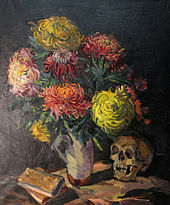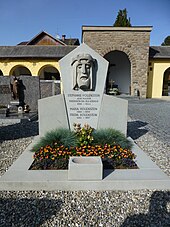Stephanie Hollenstein

Stephanie Hollenstein (born July 18, 1886 in Lustenau , Vorarlberg , † May 24, 1944 in Vienna ) was an Austrian expressionist painter who rose to a high functionary in the public art industry during the National Socialist era.
Life
childhood and education
Stephanie Hollenstein was born as the fifth child of the farmer and sticker Ferdinand Hollenstein and his wife, Anna Maria geb. Bösch, born. In her youth she worked as a cowherd on her parents' farm. It was there that the first drawings were made showing shepherds and animals. From 1892 to 1900 Stephanie Hollenstein attended elementary school in Lustenau. In November 1904 she was admitted to the Royal School of Applied Arts in Munich without the usual examination due to the drawings she had brought with her . She studied in Munich until 1908 and then opened her own painting school in Schwabing , which she ran until 1910. In the next few years she exhibited at the Munich Art Association and in group exhibitions at the Ferdinandeum Innsbruck, Bregenz and Zurich. In 1913, on the recommendation of Franz von Defregger, a scholarship made it possible for her to go on a study trip to Italy; from 1913 to 1914 she then traveled to Venice , Florence and Rome . Vincent van Gogh influenced her painting during these years .
First World War
During the First World War she initially took a paramedic course, but in May 1915 she joined the Vorarlberg “ Standschützen ” under the name “Stephan Hollenstein” . It was used on the southern front. While her comrades knew her gender, superiors only became aware of this when they visited the troops on August 4, 1915, and she was immediately sent home. It is by Viktoria Savs the second known soldier of Austria-Hungarian army during the First World War . The experience as a soldier guaranteed her public attention until the end of her life. Soon afterwards she worked as a war painter for the Austro-Hungarian war press headquarters and in this function was at the front at least three times in 1916. Later she received the Karl-Troop Cross for her service of more than 90 days at the front . In 1916/17 she also painted for the Army History Museum in Vienna, which eventually bought 87 of her works.
Twenties
After her war experience, she lived in Vienna with her friend, the doctor Franziska Gross. From 1920 to 1921 she exhibited there for the first time in an exhibition of the art community and soon afterwards in exhibitions of the Künstlerhaus Wien , the Vienna Secession and the Hagenbund .
In 1926 she was - together with Fanny Harlfinger - co-founder of the artist group “ Wiener Frauenkunst ”. She gained ever greater recognition as a painter: In 1924 Hans Ankwicz-Kleehoven wrote a detailed article about her for the Thieme-Becker artist lexicon , in which he attested her "extremely strong, yet harmonious colors" and ascribed a "thoroughly modern conception" which "always remains close to nature".
This creative period was interrupted for a long time due to a double ankle fracture, which Stephanie Hollenstein sustained in an accident in 1928. It was not until she was treated by the famous trauma surgeon Lorenz Böhler - also from Vorarlberg in Vienna - that her recovery and a new artistically fruitful phase were possible.
Travel years

In the years 1929 to 1932 she traveled a lot: In addition to Italy , she mainly traveled to South Tyrol and Switzerland . In 1931 she won a state prize for a now lost portrait of her mother, and in 1932 another for the painting "Alter Winkel aus dem Fiemme Valley".
time of the nationalsocialism

In the 1930s she became enthusiastic about the cult of masculinity and the military human ideal of fascism . Early on she secretly became a member of the NSDAP , which was banned in Austria, and after Austria's annexation to the German Reich, she officially joined the NSDAP on May 1, 1938. From July 1938 to 1943 she was chairwoman of the Vienna Women's Artists' Association, which was founded in 1938 as the successor organization to the Association of Women Artists in Austria (VBKÖ) (from 1941 Association of Women Artists of the Reichsgaue der Ostmark ). This made her one of the most influential Austrian artists in the time of National Socialism .
Amazingly, her paintings with the strongest expressionist features from the early 1930s were shown in the National Socialist exhibition “German Art”. Modern art and National Socialism did not seem to stand in indissoluble opposition neither for Hollenstein nor for the rulers (in self-perception she resembles Emil Nolde here ), and in 1938 she publicly defended the cubist work of her compatriot Albert Bechtold from Vorarlberg - albeit unsuccessfully - against the accusation To be “ degenerate art ”.
An application to be awarded the title of professor was rejected in 1942/1943 on the grounds that the artist only had "local significance". In addition, “it cannot be ascertained that her work is suitable to give the group of cultural workers she supervises in terms of the guidelines given by the guide.”
Death and legacy
In 1943 she resigned from the chairmanship of the Vienna Women's Artists' Association for health reasons, and the following year she died in Vienna of a heart attack. Her remains were transferred to Lustenau and buried in a community grave of honor . Her two sisters Maria and Frieda carefully managed their estate before handing it over to the market town of Lustenau in 1961. When the “Vorarlberger Embroidery Center” building complex was built on the site of the house where she was born, the municipal Stephanie Hollenstein gallery was also planned and opened on July 4th, 1971.
plant
In addition to portraits, Hollenstein's paintings and graphics mostly depict landscapes from her native Lake Constance region , from the Alps or from southern Italy. Her colorful, expressive style with a characteristic treatment of space earned her the nickname “Schiefmalerin”.
The most important collection of her work with 94 paintings, 150 watercolors and gouaches as well as 870 drawings, sketches and studies is in the Stephanie Hollenstein Gallery . Your estate is kept in the Lustenau community archive. Stephanie Hollenstein is the only Austrian artist to whom an extensive archive financed with public funds and an exhibition room named after her are dedicated.
Honors
- Honorary grave of the market town of Lustenau
- Bust in a small park next to the Lustenau town hall
literature
- Hans Ankwicz-Kleehoven: Hollenstein, Stephanie . In: Hans Vollmer (Hrsg.): General lexicon of fine artists from antiquity to the present . Founded by Ulrich Thieme and Felix Becker . tape 17 : Heubel – Hubard . EA Seemann, Leipzig 1924, p. 380-381 .
- Hollenstein, Stephanie . In: Hans Vollmer (Hrsg.): General Lexicon of Fine Artists of the XX. Century. tape 2 : E-J . EA Seemann, Leipzig 1955, p. 474 .
- Elmar Vonbank (Red.): Galerie Stephanie Hollenstein. Guide to the collection . (= Guide to museums and collections in Vorarlberg; Volume 5). Market town of Lustenau, Lustenau 1971.
- Liselotte Popelka (Red.): The woman in war . Heeresgeschichtliches Museum, Vienna 1986 (exhibition catalog).
- Willi Oberfrank, Helmut Gassner: Stephanie Hollenstein. 1886-1944 . Marktgemeinde Lustenau, Lustenau 1994, ISBN 3-900954-03-8 (exhibition catalog).
- Edeltraud Fürst (Ed.): The artists' association "Der Kreis". Painter and sculptor on Lake Constance. 1925-1938 . (= Art on the Lake. Volume 24). Gessler, Friedrichshafen 1992, ISBN 3-922137-83-0 .
- Evelyn Kain: Stephanie Hollenstein: Painter, Patriot, Paradox . In: Woman's Art Journal Vol. 22, 2001, pp. 27-33.
- Wolfgang Scheffknecht: 100 years of the market town of Lustenau . Lustenau 2003, ISBN 3-900954-06-2 , pp. 254-261 .
Web links
- Stephanie Hollenstein: Biography and further information on the pages of Galerie Hollenstein
- Literature by and about Stephanie Hollenstein in the catalog of the German National Library
- Entry on Stephanie Hollenstein in the Austria Forum (in the AEIOU Austria Lexicon )
Individual evidence
- ↑ a b Andreas Brunner , Ines Rieder, Nadja Schefzig, Hannes Sulzenbacher , Niko Wahl: Secret thing: live - gays and lesbians in Vienna in the 20th century. Löcker Verlag, Vienna 2005, ISBN 3-85409-435-3 , p. 99 f.
| personal data | |
|---|---|
| SURNAME | Hollenstein, Stephanie |
| ALTERNATIVE NAMES | Hollenstein, Stephan (soldier's name) |
| BRIEF DESCRIPTION | Austrian painter |
| DATE OF BIRTH | July 18, 1886 |
| PLACE OF BIRTH | Lustenau , Vorarlberg |
| DATE OF DEATH | May 24, 1944 |
| Place of death | Vienna |



